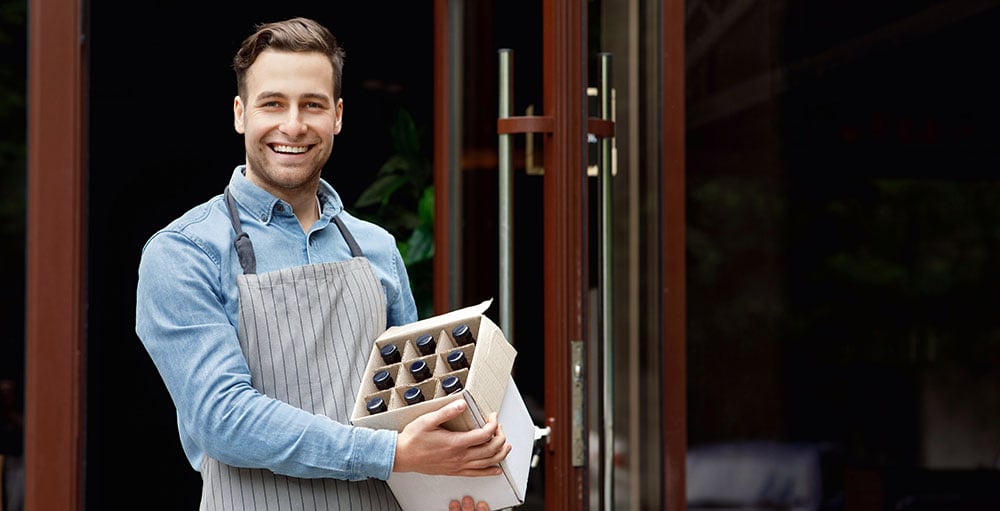COVID-19 made takeout alcohol essential for food businesses. Here’s how to set up your own to-go services.
Restaurants and other food businesses were among the hardest hit by measures to curb the spread of COVID-19. Alcohol accounts for about a quarter of most restaurants’ sales, so it makes sense to offer to-go alcohol with takeout meals to recoup some of the losses incurred during the pandemic.
If you’re planning to start an alcohol takeout service from your business, you need to make sure you do it legally and effectively. There’s more to takeout alcohol services than receiving and fulfilling basic orders. Selling alcohol to-go can be a major boon to your business, so you want to do it right!
You may be wondering where to begin. Here are a few pointers to get you started.
Check state and local guidelines
The very first thing you need to do is check what’s legal and expected in your municipality. Checking local guidelines should also give you an idea of what you’ll need as far as licenses or signage.
California was among the first states to take advantage of the changing situation early on in the pandemic. As of March 20, 2020, all restaurants in the state have been allowed to sell beer and wine for pickup and delivery, as well as cocktails and premixed drinks for pickup, as long as the takeout/delivery containers were sealed with no opening for a straw and the drinks were sold along with food.
Any California restaurant offering these options also had to post an onsite or online notice letting customers know about open container laws.
Learn about California’s latest to-go alcohol laws
On October 8, 2021 Senate Bill 389 was approved that allowed restaurants to continue to sell cocktails and premixed drinks to-go, effective until December 31, 2026.
With the passing of this bill, any licensed “eating place,” along with beer and wine manufacturers or craft distillers that prepares and sells food on-site, can continue to sell alcoholic beverages to-go until 2026, given that the following regulations are followed:
- Beer, wine, liquor and mixed drinks are permitted to be sold to-go
- Customers must buy food with their drinks
- Customers are limited to two takeout alcoholic beverages per meal
- Takeout alcoholic beverages must be sold in manufacturer-sealed containers or containers with sealed caps or secure lids
- Takeout cocktails can only contain up to 4.5 ounces of liquor
- Takeout wine must be sold in single-serve containers
- All takeout alcohol containers must have a clear label indicating it contains alcohol
Eligible licensees that are interested in providing alcoholic beverages to-go must first alert the Department of Alcoholic Beverage Control of their intent to sell takeout alcoholic beverages before doing so. The department can choose to restrict or prohibit these privileges.
Learn more about the alcoholic beverages to-go law.
Determine the demand
Find out what kind of to-go drinks make sense given your business and customer base — do they lean toward wine, beer or cocktails? What would the deal need to include to entice them, and to expand your customer reach to new markets? Look into what has or hasn’t been working for similar companies in the area. Put together a survey and ask your customers directly what they’d like to see.
Create and market a to-go food menu
Most states, including California, stipulate that alcohol can only be served on a takeout basis when it is an accompaniment to food. With that in mind, establish a to-go friendly menu with items that travel, refrigerate and reheat well, such as grilled veggies, fried chicken, barbecue and noodle dishes. Curate craft cocktails that complement each menu item, and market them together. Let staff be creative here — if you have a mixologist on payroll, let them work with the chef to come up with signature drink-and-dish pairings!
If you plan to offer cocktail kits (DIY cocktails for customers to make at home using the kit provided by your establishment), purchase any supplies needed for these kits, such as a branded tumbler, straws, napkins, coasters, jiggers, stir spoons — this really depends on how high-end you want your kit to be, keeping costs for the customer and your business in mind.
Let customers know through your typical advertising channels that they can now purchase to-go alcohol. Clearly set prices and be transparent on the fact that you’ll be checking identification.
Be diligent about ID checks
Even when alcohol is being consumed off-premises, it’s still your responsibility to ensure that those purchasing and consuming it are of legal age — at least 21 years old. If you plan to offer to-go drinks, the process is simplified as you can still check IDs and sell products directly to the customer in person.
Alcohol servers must still follow the proper techniques for checking ID. They must ensure the ID is not expired, has a photo of the individual and their signature, shows no signs of tampering (e.g. pinholes, a tilted photo, bumps in the lamination) and of course, that the person ordering alcohol to-go is of legal drinking age.
Follow California’s other alcohol service laws
If you’re operating in the Golden State, you’ll need to keep up to date with all California alcohol service laws. ABC is also keeping some provisions that have evolved since the early days of the pandemic in place, such as these alcohol delivery regulations:
- Delivery sales transactions must occur at the licensed business, which means payment cannot occur at the time of delivery
- Curbside delivery is still allowed, as is free delivery
- Craft distillers may only exercise off-sale privileges at their licensed premises
- “Virtual” meet the winemaker/brewer dinners can still be held as long as the on-sale retailer conducts them
Other rules are changing, such as those to do with retail-to-retail transactions and drive-thru windows.
While many rules are evolving in response to health priorities, many principles around safe and responsible service remain the same. That’s why it’s also a good idea to ensure staff are trained in responsible beverage service.
Userve’s California RBS Certification Training is perfect for bartenders, alcohol servers and managers and covers all areas of responsible beverage service, including protecting customers and safeguarding your business from any liabilities.
Not only is requiring alcohol server training for all the bartenders and servers in your licensed business a good idea — it will also soon be required by law! Starting July 1, 2022, all on-premises alcoholic beverage servers and their managers in California must complete RBS Training and pass the RBS Certification exam to legally serve alcohol.
Stay compliant with all of California’s alcohol service laws by taking Userve’s state-approved RBS Certification Training Course!

